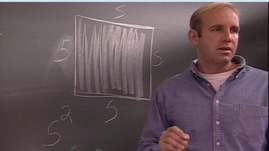Teachers' Domain - Digital Media for the Classroom and Professional Development
User: Preview



Area is the measure of the surface inside a flat figure. Area is measured in square units. Multiply the length times the width to get the square units.
These resources are part of KET's Measurement and Geometry collection.
This video segment originally appeared in KET’s GED Connection series.
To tile a floor, you have to know how much area there is to be covered. Area is the measure of the surface inside a flat figure. Area is measured in square units. How do you find the surface area of a floor? You could cut a square foot out of cardboard and see how many times it will fit in the space. But instead, you can measure the length and width of the room and multiply. For example, for a rectangular space, the length times the width equals the surface area of the floor. We express this as a formula:
A square is simply a rectangle with sides that are the same length. You can measure one side and multiply by four, but you can also use the formula for finding the area of a square :
The formula for the area of a square uses a special number called an exponent, or power. The variable s stands for the length and side of the square. This number is called the base. The small 2 is the exponent. An exponent tells you how many times to multiply the base by itself. The expression s2 is read “s to the second power” or “s squared.” It means “s multiplied by s.”
Have learners measure the area of surfaces (tables, desks, chalk or whiteboards, etc.) in the room. You may also want to have them measure the area of a nearby hallway or classroom.
If possible, bring a floor plan of a house to show learners. Then have them work together to create their own floor plan for a one-story house. Have them label all measurements and calculate the area in square feet for each room.
Have learners complete the Reroofing Your Uncle’s House activity from KET’s Teachers’ Domain. If you have enough computers for learners to work individually or with a partner, have them visit http://goo.gl/maHjJ to access the activity. You may want to assign different parts of the roof to different teams and then add all the results at the end to find the total area of the roof.
 Loading Standards
Loading Standards